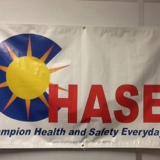Title Page
-
Operator
-
Operator ID#
-
Inspection Date
-
Inspection Unit
-
Location of Audit
-
Exit Meeting Contact
-
Inspection Type
-
Pipeline Safety Representative(s)
-
Company Representative to Receive Report
-
Company Representative's Email Address
-
Prepared by
STORAGE & COMPRESSOR STATION - FIELD CHECKLIST
-
Headquarters Address Information
-
Emergency Phone#
-
Fax#
-
Official or Mayor's Name
-
Phone#
-
Email
-
Inspection Contact(s)
-
Title
-
Phone No.
VALVE MAINTENANCE
-
[192.179(b)] Are transmission valves protected from tampering or damage?
-
[192.745(a)] Were the valves inspected accessible?
-
[192.745(a)] Was the condition of the valve box checked?
PRESSURE TESTING
-
[192.719(a)] Is pre-tested transmission pipe inventory maintained for use in an emergency?
MARKING OF MATERIAL
-
[192.63(a)] Does the operator's components and pipe contain the required markings?
DAMAGE PREVENTION
-
[192.614] Does the operator have a valid notification of planned excavation activities?
-
[83 IL Adm. Code.265.40(a)] Did the operator complete the locating activities in the specified timeframe?
-
[192.614(c)(5)] Were temporary markings made in accordance with the operator’s Operation and Maintenance Manual?
-
[192.707(a)(1)] Are line markers placed and maintained as close as practical over each buried main and transmission line located at each crossing of a public road and railroad?
-
[192.707(a)(2)] Are line markers placed and maintained as close as practical over each buried main and transmission line located wherever necessary to identify the location of the transmission line or main to reduce the possibility of damage or interference?
-
[192.707(c)] Are line markers placed and maintained as close as practical over each buried main and transmission line located above ground?
-
[192.707(d)(1)] Do the operator's line markers contain the following information: The following must be written legibly on a background of sharply contrasting color on each line marker: The word "Warning," "Caution," or "Danger" followed by the words "Gas (or name of gas transported) Pipeline" all of which, except for markers in heavily developed urban areas, must be in letters at least 1 inch (25 millimeters) high with ¼ inch (6.4 millimeters) stroke?
-
[192.707(d)(2)] Do the operator's line markers contain the following information: The following must be written legibly on a background of sharply contrasting color on each line marker: The name and phone number (including area code) of the operator where the operator can be reached at all times.
CATHODIC PROTECTION
-
[192.463(a)] Is the applicable cathodic protection criteria contained in Appendix D of this part being followed?
-
[192.465(a)] Were pipe to soil readings taken?
-
[192.465(b)] Were rectifier installation inspected?
-
[192.465(a)] Were isolated mains/services tested?
-
[192.465(c)] Were critical/non critical bonds tested?
-
[192.467(a)] Is electrical isolation provided by use of insulated meter spud, valve, union, or flange?
-
[192.467(c)] Were casings installations tested for electrical isolation?
-
[192.479(a)] Is the above ground piping coated or painted as required?
-
[192.479(c)] Is the pipeline free of corrosion or pitting?
PRESSURE LIMITING AND REGULATING DEVICES (MECHANICAL)
-
[192.739(a)(2)] Was each pressure limiting station, relief device (except rupture discs), and pressure regulating station and its equipment subjected at intervals not exceeding 15 months, but at least once each calendar year, to inspections and tests to determine that it is adequate from the standpoint of capacity and reliability of operation for the service in which it is employed?
-
[192.739(a)(3)] Was each pressure limiting station, relief device (except rupture discs), and pressure regulating station and its equipment subjected at intervals not exceeding 15 months, but at least once each calendar year, to inspections and tests to determine that it is except as provided in paragraph (b) of this section, set to control or relieve at the correct pressure consistent with the pressure limits of §192.201(a)?
-
[192.739(a)(4)] Was each pressure limiting station, relief device (except rupture discs), and pressure regulating station and its equipment subjected at intervals not exceeding 15 months, but at least once each calendar year, to inspections and tests to determine that it is properly installed and protected from dirt, liquids, or other conditions that might prevent proper operation.?
-
[192.317(b)] Is each above ground transmission line or main protected from accidental damage by vehicular traffic or other similar causes?
-
[192.741(a),192.741(c)] Were telemetering and/or recording gauges inspected for abnormally high or low pressure indications?
-
[192.199(d)] Did the pressure relief or pressure limiting devices inspected to determine if the support was made of noncombustible material?
-
[192.199(e)] Did the pressure relief or pressure limiting devices inspected to determine if the discharge stacks, vents, or outlet ports were designed to prevent accumulation of water, ice, or snow, and located where gas can be discharged into the atmosphere without undue hazard.
-
[192.199(h)] Was each valve, designed to isolate the system under protection from its source of pressure, secured to prevent unauthorized operation of any stop valve that will make the pressure relief valve or pressure limiting device inoperative?
COMPRESSOR STATION INSPECTION
-
[192.163(e)] Does the equipment and wiring within compressor stations conform to the National Electric Code, ANSI/NFPA 70?
-
[192.163(c)] Does the main operating floor have at least two separate and unobstructed exits?
-
[192.163(c)] Can each exit door latch open from inside without a key?
-
[192.163(c)] Does each exit doors swing outward?
-
[192.163(d)] Does each fence around a compressor station have at least 2 gates or other facilities for emergency exit?
-
[192.163(d)] Does each gate located within 200 ft. of any compressor plant building open outward?
-
[192.163(d)] When occupied, does the gate open from the inside without a key?
-
[192.165(a)] If applicable, are there liquid separator(s) on the intake to the compressors?
-
[192.165(b)(1)] Do the liquid separators have a manual means of removing liquids?
-
[192.165(b)(2)] If slugs of liquid could be carried into the compressors, are there automatic dumps on the separators, automatic compressor shutdown devices, or high liquid level alarms?
-
[192.167(a)(1)] Does the compressor station have an ESD that is able to block gas out of the station and blow down the station piping?
-
[192.167(a)(2)] Does the compressor station have an ESD that will discharge gas from the blow down piping at a location where the gas will not create a hazard?
-
[192.167(a)(3)(i)] Does the compressor station have an ESD that will shut down gas compressing equipment, gas fires, electrical facilities in compressor building and near gas headers?
-
[192.167(a)(3)(ii)] Does the compressor station have an ESD that will maintain necessary electrical circuits for emergency lighting and circuits needed to protect equipment from damage?
-
[192.167(a)(4)(i)] Does the compressor station have an ESD that is operable from at least two locations, each of which is outside the gas area of the station?
-
[192.167(a)(4)(ii)] Does the compressor station have an ESD that is operable from at least two locations, each of which is near the exit gates, if the station is fenced, or near emergency exits, if not fenced? AND
-
[192.167(a)(4)(iii)] Does the compressor station have an ESD that is operable from at least two locations, each of which is not more than 500 feet from the limits of the station?
-
[192.167(b)] Does each compressor station that supplies gas directly to a distribution system (with no other adequate sources of gas available) have an emergency shutdown system that will not function at the wrong time or cause unintended outages?
-
[192.169(b)] Does each vent line that exhausts gas from a pressure relief valve of a compressor station extend to a location where the gas may be discharged without hazard?
-
[192.171(a)] Do compressor stations have adequate fire protection facilities?
-
[192.171(b)] Does each compressor station prime mover, other than an electrical induction or synchronous motor, have an automatic device to shut down the unit before the speed of either the prime mover or the driven unit exceeds a maximum safe speed?
-
[192.171(c)] Does each compressor unit in a compressor station have a shutdown or alarm device that operates in the event of inadequate cooling or lubrication of the unit?
-
[192.171(d)] Does each compressor station gas engine that operates with pressure gas injection equipped so that stoppage of the engine automatically shuts off the fuel and vents the engine distribution manifold?
-
[192.171(e)] Does each muffler for a gas engine in a compressor station have vent slots or holes in the baffles of each compartment to prevent gas from being trapped in the muffler?
-
[192.173] Is each compressor station building ventilated to ensure that employees are not endangered by the accumulation of gas in rooms, sumps, attics, pits, or other enclosed places?
-
[192.605(b)(3)] Are facility maps current and up-to-date?
-
[192.735(a)] Are combustible materials in quantities exceeding normal daily usage, stored a safe distance from the compressor building?
-
[192.735(b)] Are above ground oil or gasoline storage tanks protected in accordance with NFPA standard no. 30?
-
[192.736(b)] Does each gas detection system continuously monitor the compressor building for a concentration of gas in air, and if that concentration of gas is detected, have an alarm system to warn persons about to enter the building and persons inside the building of the danger?
OPERATOR QUALIFICATION
-
Was a PHMSA Form 15 Operator Qualification Field Inspection Protocol Form completed?
GENERAL STAFF NOTES
-
undefined
Sign Off
-
Name and Signature











